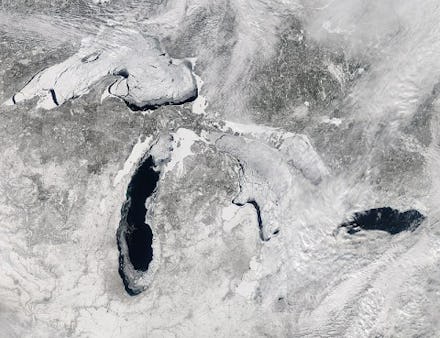The Great Lakes Are Over 90% Frozen and Could Break a Record This Week

The big freeze: Brrrrr. It's been a long winter. None more-so than for those in the Midwest, who have had to endure the full brunt of the polar vortex. Though it's March, many places are still experiencing subzero temperatures. On the plus side, these cold temperatures have made for admittedly pretty pictures of frozen lighthouses, caves and skylines littering our social media streams. But perhaps the most iconic images have been of the frozen Great Lakes.
This week the Great Lakes ice coverage has reached 90.5% according to the Great Lakes Environmental Research Laboratory, which has been recording this information since the '70s. With cold temperatures set to continue for the next fortnight, the record of 95% ice coverage set back in 1979 is poised to be broken.
Image adapted from NOAA
Four out of the five great lakes now have ice coverage of over 90%. Though parts of Niagara Falls have frozen over, Lake Ontario trails behind the others with 45% coverage, mostly because it's deeper relative to its smaller exposed surface area. Water is very good at holding heat, so the bigger this ratio, the slower it will ice up.
In comparison, Lake Superior, which is further north and has a larger surface area, is now 95% covered with ice, up from 78% last week. Since NOAA records began, Lake Superior has only frozen over once, in 1996.
Image adapted from NOAA
What have been the effects? The polar vortex has been a bit of a nightmare for the Coast Guard, which is mandated to keep the shipping lanes open during a 42-week season. As a result, the Coast Guard's ice breaker, Mackinaw, has been working overtime to clear the path for some 57 U.S.-flag vessels that carry important materials such as iron ore, limestone and coal. The vessels transport more than 115 million tons of cargo per year, worth more than $20 billion.
Image Credit: NASA
Image Credit: NOAA
In Wisconsin, Lake Superior's freezing has opened a new place of exploration for locals. The Apostle Islands are ordinarily only accessible by water, but this winter eager photographers have been able to reach it by walking 2 miles over the ice. Their reward? Dozens of extraordinary frozen caves. The ice caves, full of beautiful icicle curtains, were created when waves splashing against the rock began to freeze on the sandstone cliff. They've been an amazingly popular attraction with nearly 78,000 visitors this season according to the National Parks Service.
Image Credit: Brian Peterson/AP
Interestingly, the good news for those waiting desperately for summer is that the arctic conditions will actually help increase the water levels in the Great Lakes — reversing a 15 year trend of decreases — since the large coverings of ice left behind will slow down evaporation. The Great Lakes Environmental Research Laboratory, predicts that the water levels of Michigan and Lake Huron will increase by 10–12 inches this upcoming summer, which is good news for agriculture and industries that depend on the waterways. When water levels are low, commercial ships have to light load there vessels, losing $11,000 – $22,000 in profits a day per every inch of decreased clearance.
How far can they freeze? The Great Lakes' freezing this winter is certainly a significant contrast from last year, when the five lakes only reached 38% ice cover. It also goes against the last several decades' trend of average ice coverage decreasing 2% per year. Overall the Great Lakes have lost 71% ice cover since 1973 according to research published in the Journal of Climate.
A total freeze this winter looks unlikely because temperatures after Friday, while still being seasonably below average, are predicted to rise to over 30 degrees Fahrenheit. But the next few days will be cold, and with 4.9% left to reach the 1979 milestone, there's a good chance that we'll crown this long polar vortex-affected winter as the biggest freeze the Great Lakes ever recorded.